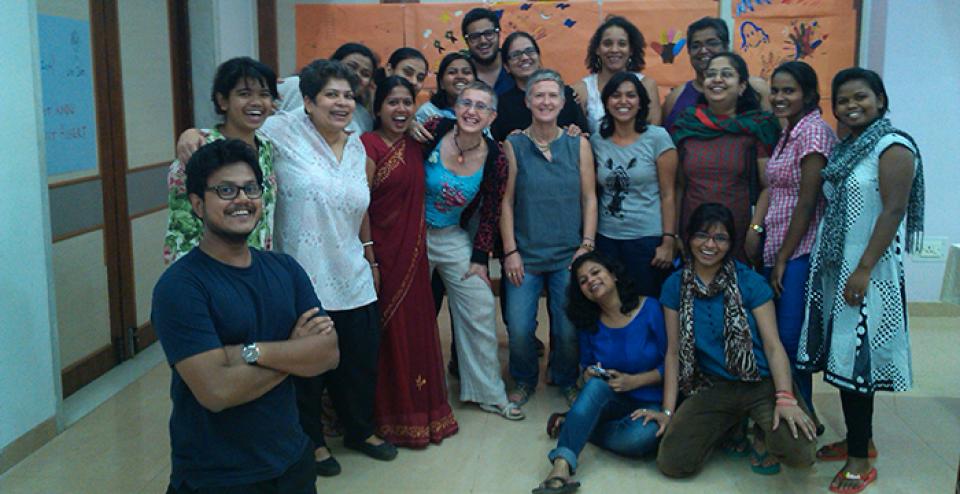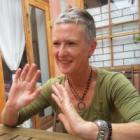
Digital storytelling as creativity, witness, transformation and power.
* All quotes are taken from participants of digital storytelling workshops who wish to remain anonymous.
“Now I feel like my voice will be heard and I believe it will make a
difference”
It is a sacred act to tell and to listen to stories. Some of our stories are rooted so deep in our cells, psyches and hearts, that it takes an act of courage to find the words to tell them. We each contain a multitude of stories that shape and make us who we are. We have stories that we can name as dreams or visions of how we imagine a better world for ourselves, communities and families. It can also be a political act to tell a story. As feminists we are often called on to tell our stories of violence, resistance, pain but also of overcoming, surviving, of love, of friendships. We gather in small and large groups to witness, listen, celebrate, hold and honour each other through our stories. As we listen, we try and fit ourselves into the skin of the other to understand the pleasure, pain and the journey of another.
The universe is made of stories, not atoms. (Murial Rukeyser)
In this connected world which is often mediated by the digital and the internet, we increasingly read, listen and watch through screens and devices. This can be powerful and transformative if we have the access and confidence to connect in this way.
Our journey with digital storytelling
In 2007 APC member Women’sNet met up with staff from the StoryCentre and learnt a powerful methodology called Digital Storytelling. The StoryCentre’s tag line is “Listen Deeply, Tell Stories” which is what we at APC Women’s Rights Programme have been doing since then. Digital Storytelling is now a popular way of engaging people to tell stories in many sphere’s of life but it is the methodology that is critical to us as feminist activists. The definition we work with is:
“Digital stories are stories produced, stored and disseminated using digital media. We conceptualise digital story telling as a recording and documentation method which foregrounds the voice and experiences of story tellers as primary in the process of storytelling. The focus is on the story tellers’ control over the medium, choice of words (narration), pictures and music so that the process is as powerful for the story teller as the end product is to the viewer.”
So a digital story, once it has been produced, is like a short (3-5 minute) movie with narration, animated images and can have music, sound effects and text for empahsis or for translation of language. Digital storytelling uses basic equipment with free and open source software, so keeps costs at a minimum. Digital stories are not slick or smooth products but are powerful because they are created by the storyteller, whatever their skill level and are entirely personal. It is a revolutionary act to take control of our voices and the technology to speak of our own lives.

Initially we hosted digital storytelling workshops for two main reasons: one was to encourage women to use digital tools and be comfortable with technology in a way that was engaging, had a purpose, and hosted in a safe space where no questions are wrong. Training in digital tools was and still is often a fraught space for women with technical language, insensitive trainers and very little connection between the value of these tools and women’s lived realities. We wanted to shift this power dynamic. The second was that as feminists, we believe that telling stories does not have to be “contracted out” to others; it is far more powerful and transformative for people to create and share their own stories. Women’ stories, particularly from the global south, are too often mediated through another. We wanted women to represent themselves through the storytelling. And this can be done via the digital storytelling.
“I had a chance to be taught how to use the computer. I had to tell my story in a movie style (cool!)”
The methodology and process
The methodology takes people through a creative process of body-mapping, word play and games to reach for the story they want to tell. We screen digital stories to open up a discussion on the process and ways of visually representing a story by shaping it into a poem, letter, animated comic strip, dream and more. Representation – the ethics of storytelling – is critical, and involves asking questions such as: Can all stories be told by the people who experience them? What about stories we find hard to listen to? Is there such a thing as impartiality or objectivity? These challenge the storyteller to think deeply before writing their narrative. At the core is that we tell our own stories. We find the “I” in the story.
After the storytellers write their narrative, we facilitate a storytelling circle that is held as a safe, confidential and respectful space. It is important to approach the circle with sensitivity because some stories are being told for the first time. It is important to make sure that participants have some emotional support for the duration of the workshop and beyond. People in the storycircle are encouraged to give feedback in an affirmative way. Prompts may include: What did you see, hear, smell? What is unclear? What do you want to know more about? We close the circle with a poem and a ritual that honours each person’s story.
“Always talking and sharing your problem has a way of moving something or being in touch with your own emotional scars. To see others who have done something for themselves makes you to be more stronger and set alight your own candle and you start making more resolutions”
Once the circle is complete, the narrative is crafted into a story script. Sessions on storyboarding, narrative structure, and visual imagery assist storytellers in developing their scripts to a place where they are ready to be digitised. We encourage the use of original photos, hand-drawn pictures and documents such letters or certificates – images with emotional content that give visual meaning to the script. We start structuring the story using mostly free and open source software. The ethics of imagery are also important. We discuss the politics of representation, and key to this is the safety of those whose images are shown. We insist that storytellers get permission if they want to use images of other people. Often the workshops we host are with activists who could be at risk if their stories reveal their identity, and we teach innovative ways of making faces unrecognisable.

Creating agreements between all present, participants as well as facilitators, is important to ensure that the stories stay with the group until people are ready to release them further, if at all. All stories are owned by the creators of the stories, and they have the right to screen and circulate their stories or keep them private. We discuss issues of informed consent and distribution carefully and are clear that storytellers can withdraw consent at any time. The storytellers decide if their stories will be released into the public domain or not.
“I’ve let go of the pain I’ve been hiding inside”
Our stories shift and change over time. We can grow out of stories. So it is important that people know that their stories are their own and can be removed from public spaces should they choose. In the Feminist Principles of the Internet the principle of Memory holds.
“We have the right to exercise and retain control over our personal history and memory on the internet. This includes being able to access all our personal data and information online, and to be able to exercise control over this data, including knowing who has access to it and under what conditions, and the ability to delete it forever.”
And once the stories have been made we sit together and watch each others’ movies together as a way of celebrating and closing the space.
Hosting and facilitating digital storytelling workshops
The gift of listening to stories cannot be measured nor words found to describe the process adequately. We insist that facilitators go through a digital storytelling workshop and create their own stories before facilitating a workshop. This is for facilitators to know and understand the process from the inside and the strength and courage it takes to be part of the story circle. As facilitators, we always share one of our own stories so that each person in the room has opened in some way to the vulnerability and magic.
The politics of facilitating is a deep and delicate process that cannot be under-estimated. APC WRP are aware that facilitators need, as far as is possible, to come from the places or realities of the participants and that we all have different ways of storytelling. There is no one or right way to tell a story
Why digital storytelling?
Over the years APC WRP have partnered with organisations to host digital storytelling workshops in many countries to facilitate creating stories around disability, sexuality, sex work, violence against women, reproductive justice and evaluation of projects, among other topics. The digital stories have been used for advocacy, for evaluation of projects to find the most significant personal or project change or for being heard, or just sharing a story to find some healing and resolution.
Every single workshop has been a privilege to facilitate.
You can visit our new digital storytelling platform which we have launched in Dec 2016.
- 9911 views






Add new comment